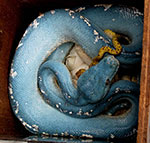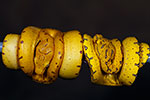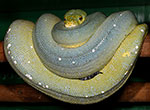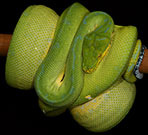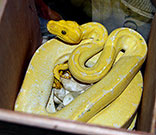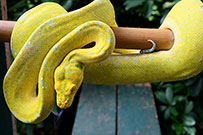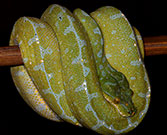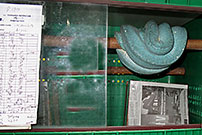On Green Tree Pythons - Interview with Vladimir Odinchenko, 2013
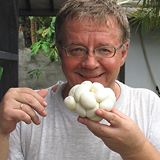 Vladimir Odinchenko is one of the most prominent and accomplished green tree python
breeders in the world. The man behind Terraria Indonesia - Indonesian python breeding farm represented by the Bushmaster Reptiles, Inc in the US - shares his invaluable knowledge with us.
Vladimir Odinchenko is one of the most prominent and accomplished green tree python
breeders in the world. The man behind Terraria Indonesia - Indonesian python breeding farm represented by the Bushmaster Reptiles, Inc in the US - shares his invaluable knowledge with us.
ViridisPython: Vladimir, let's start with some biographical facts. Where were you born? What sparked your interest in reptilians? How did you come to work at Terraria Indonesia?
Vladimir Odinchenko: I was born in Kyrgyzstan, Central Asia. As far back as I can remember, I've always been fond of animals. My love for reptilians developed gradually. At first, I would catch and bring home little skinks, which at that time were abundant in my hometown - Frunze. Later on, I would lay my hands on dice snakes, Dione rat snakes, and shchitomordniks (Gloydius halys). My first snake species, that I successfully bred in captivity, was Dione rat snake (Elaphe dione).
At one point I was very lucky to meet Vasilko Vasilyevich Ozarovsky, who happened to live in my town. Back then, Ozarovsky had quite an impressive collection, including Indian and African rock pythons, Cuban boas, several species of rat snakes, cobras and blunt-nosed vipers (Macrovipera lebetina). I would spend my entire days helping him out with the snake chores. He was the first person in the USSR to start breeding snakes in captivity. In those years (70-s) he was successfully reproducing a number of species of rat snakes, blunt-nosed vipers (several generations in captivity!), and Cuban boas. It was Ozarovsky, whom I got my first skills of keeping reptiles in terrarium from. He died in 1985 from a bite of a Central Asian cobra (Naja oxiana). He was 85.
In 1982 I began to work at the Moscow Zoo, Department of Herpetology. I was involved in boa and python breeding programs. Over my years at the zoo, we managed to reproduce a number of interesting species such as L. albertisi, L. mackloti, M. amethistina, M. viridis, A. papuana, several species of the genus Python, Loxocemus bicolor. We had success at breeding pretty much any species we could put our hands on and match pairs (back then it was not as easy as it is these days). And when we finally acquired Boelen's python, it turned out that this species was a tough nut to crack. An idea to travel to the homeland of this legendary serpent - New Guinea mountains - came up and resulted in my first trip to Indonesia. During my second trip to New Guinea I met Buntje Soetano, the owner at C.V. Prestasi. He was the one supplying us with the Boelens at the Zoo, and when we met in person, a decision was made to build a python breeding farm on Java, Indonesia. Much to my regret, my time at Prestasi was not long, and in about a year and a half I moved to Terraria Indonesia. Kamuran Tepedelen of Bushmaster Reptiles, was the one to help me out with my new employment, and I'm very thankful to him.
ViridisPython: What are your hobbies, Vladimir?
Vladimir Odinchenko: I like fishing and photography. There were times in my life when I was thinking about turning one of those hobbies into a career.
ViridisPython: Speaking of reptiles, what is your favorite species to work with, and what animals would you like to work with in the future?
Vladimir Odinchenko: Pythons are my favorite species of snakes, the most favorite being Reticulated python. But most of all I love working with the arboreal species. In the future, I'd really want to work with the Emerald Tree Boa, especially its Amazon Basin variant - Corallus batesii. Ironically, I've never seen this snake live. The only ETBs I've seen were fixed museum specimens.
ViridisPython: Let's talk about Boelen's python. Why, in your opinion, is it so difficult to reproduce this species in captivity?
Vladimir Odinchenko: This snake is a legend to me. Even today I can talk Boelens for hours, and there were times when I was completely obsessed with them and couldn't really think of anything else. During my last 2-3 years at the Moscow Zoo, we were receiving this species directly from Indonesia. Those were large, adult animals. Often their overall health condition was very poor, and majority would die within a year. In most cases, the main cause of their death was heavy ascarid and pentastomid infestations. We discovered 7 different species of helminths in them, the most harmful being Ophidascaris papuanus and, of course, Pentastoma spp. (at least 2 species). Debilitated animals were prone to "catching" bacterial infections, both internal and external. But that is a separate topic, which I'm not very proficient in. A whole different story is when you can acquire captive bred pythons. They usually take less time to settle in and are free of parasites. I want to mention, that we rarely had any health issues in these pythons on our farm in Indonesia. Even the worst cases of stomatitis would heal pretty quickly. Biological peculiarities of this species should also be taken into account. I believe, eventually breeding Boelens in captivity will become a common thing, as it has happened with other once problematic species.
ViridisPython: How long have you been working with the green tree pythons?
Vladimir Odinchenko: I acquired my first green tree pythons, back when I was working at the Moscow Zoo. Two hatchlings were given to us as a gift by Jonas Wahlstrom of Skansen Zoo, Stockholm, in or around 1985. And some time later, we received a truly royal gift from Trooper Walsh of Washington National Zoo - in my opinion, the world's most prominent green tree python breeder to date. He sent us 10 chondros of various ages meticulously tucked in pantyhose! Those were the chondros I would successfully breed in a short while. We began producing chondros on a large scale, when I moved to Indo.
ViridisPython: What is your favorite locality?
Vladimir Odinchenko: It's difficult to say which locality I like the most. Tastes change with time, you know. Aru type has always been one of my favorites. Jayapura is another favorite of mine, as are Cyclops and Lereh. One of the things I like about them is that the hatchlings usually are easy starters compared to other locales. I like Manokwari and Nabire a lot. In fact, I like all of them. Every locality type has its own benefits and drawbacks. For example, Kofiau babies are difficult feeders, and Biaks are usually bad-tempered.
ViridisPython: What was the approximate age of the oldest Chondro you have ever dealt with?
Vladimir Odinchenko: I'd say, 20 years is quite reachable age. At Terraria Indonesia, we would acquire adult specimens - at least 5 years of age, could be older. Some of them, especially Aru and Merauke, while continuously producing offspring, have lived at the farm since my first days of employment at Terraria - for over 12 years. I'm sure, some of those very first animals are still there.
Photo: One of the oldest Aru females. I'm sure, she is over 15 years old.
ViridisPython: Sizewise, what are the largest and the smallest races of the green tree pythons?
Vladimir Odinchenko: I'd say, Merauke is the largest race. When they are born, the babies are usually twice as big as the other races that I've worked with. Other areas have giants too, though. One of my Sorong females measured at 205 cm (appr. 6.7') in length. Aru and Biaks can be quite large as well. As far as the smallest race, I would say - Lereh. It's possible though, I just never happened to come across large-sized Lereh's.
Photo: 1 day old Merauke (left) and Manokwari (right). Merauke is almost two times bigger!
ViridisPython: What was the largest Chondropython, that you have ever seen?
Vladimir Odinchenko: Probably, the largest one I've seen was the Merauke female. Never weighed her, but she was about 210 cm (appr. 6.9') long. Quite large are mixes of Merauke with other localities, like Merauke x Biak.
Photo: Sorong female, over 2 meters long.
ViridisPython: Do you have any "favorites" in your collection of green tree pythons? You know, animals that get more of your attention than the others.
Vladimir Odinchenko: I've always had "favorites", but they hardly get more of my attention. Working at a large-scale python farm is different from keeping these animals as pets. Even working with them at the Zoo was an entirely different experience. Those "favorites" not necessarily were of some rare locality or had some unusual coloration. As an example, my absolute favorite has always been one Lereh female. Having lived at the farm for over 12 years, she's given us 9 clutches. But that's not the reason I love her. There was some kind of individuality and humbleness in her. It's difficult to explain.
ViridisPython: Thinking of all the Chondros, that you have dealt with throughout your career, would you be able to pick out the "one and only"? What was special about it?
Vladimir Odinchenko: As I just mentioned, there was one Lereh female. There was one very beautiful Biak female - founder of many mixed bloodlines. There was a Jayapura male, who was extremely evil, a trait rarely seen in this locale. He would start lunging at the glass door like crazy, as soon as he'd notice someone approaching his cage. We would always have to remove him from the cage to clean it. But if I had to pick out the one and only, that would be the two-headed Jayapura baby from a 2002 clutch. Fully formed, it never managed to hatch from the egg. There's a picture of it in Karl-Heintz Switak's remarkable book "Adventures in Green Python Country".
ViridisPython: Speaking of green tree pythons from Kofiau Island, what is the approximate ratio of the animals preserving their yellow coloration in adulthood?
Vladimir Odinchenko: Some chondros from Kofiau Island can stay yellow for a long time. 2-3 of my females would stay bright-yellow, with some almost white spots, right until their first clutch. After the babies would hatch, the females would shed and turn green. There was one male, who would keep his not so vivid, but still yellow coloration until death. I don't know how old he was. He came to the farm as an adult and had lived there for 3 years. One of the females, that was born at Terraria and owned by a friend of mine, would stay yellow until her second(!) clutch. She shed and turned green after that anyway. Our holdbacks from the yellow females all turned green at 18 months of age.
I myself have been to Kofiau Island twice. Of course, I was looking for adult yellow pythons. But the locals explained to me, that adult pythons are green. While they are juveniles, they stay yellow. Those statements came from people who were born on Kofiau and had lived there their entire life - same people, who were catching those pythons.
Photo 1: The male who stayed yellow his entire life.
Photo 2: Still yellow female.
Photo 3: 2-year-old juvenile, born to previously mentioned female.
ViridisPython: Is there a significant difference in coloration between Manokwari and Arfak Mountains chondros?
Vladimir Odinchenko: I know well what the pythons from Manokwari look like. They were caught and brought to us directly from Manokwari. But I'm not so sure, that what we had as Arfak was indeed Arfak, so I can't answer this question with 100% certainty. All the Manokwari chondros that I've seen, looked more or less the same. Those that came to us as Arfak, looked differently. Not too much though.
Photo 1: Manokwari Female.
Photo 2: Supposedly "Arfak". Female before laying.
ViridisPython: On average, what is the term of maternal incubation in green tree pythons? Does it depend on the parents' locality?
Vladimir Odinchenko: On average, pure locality-type maternally incubated clutches usually hatch in 49-51 days. Merauke clutches take a little longer to hatch -
55-56 days. When
maternally incubating eggs, females are kept in the nest boxes with the ambient temperature being around 29-30C (84-86F). For mixed locale clutches, the term of incubation can be longer. The longest
term I've ever recorded was 61 days. It was a clutch from a Kofiau x Biak female, sired by a Merauke x Biak male. My records don't state whether the clutch was incubated maternally or artificially, but
the hatch rate was 100%. One more thing - I haven't noticed a substantial time difference between maternally and artificially incubated clutches. When we go for artificial, the temperature in the incubator
is set to 30C (86F), but in reality it fluctuates from 29C (84F) to 32C (89.6F), or even higher on really hot days.
ViridisPython: In cases when the female incubates the eggs herself, what are the chances of one or several bad eggs ruining the whole clutch?
Vladimir Odinchenko: There's always a chance like that. 100% egg loss, although being a rare occasion, does happen with both maternal and artificial incubation. We've had cases, when some of the maternally incubated eggs would go bad, and the rest would hatch with no problem. Yet, in my opinion, bad eggs should be removed promptly, which is only possible with artificial incubation. In my experience, chondro eggs tended to be much more fragile, than the eggs of any other species of pythons that I've worked with.
ViridisPython: Does the temperature of incubation affect the male/female ratio in a clutch of green tree python eggs?
Vladimir Odinchenko: Although I've never conducted such observations, that's an established and experimentally confirmed fact. On average, we'd get a more or less equal amount of both sexes, but, as I just mentioned, we've never specifically made such observations, trying to have the babies eat several times and ship them out as fast as possible. At times, there were way too many of them! Our record stands at 7 clutches in one day.
ViridisPython: What, in your opinion, are the main causes of prolapse in green tree pythons?
Vladimir Odinchenko: There may be several different factors causing prolapse. In adults, it's overfeeding, sedentary lifestyle, vitamin deficiency - especially A and D. Most prone to prolapse are 1-3 month old neonates. The feces of those baby pythons, when examined through the microscope, would reveal lots of python teeth. I believe, it was the result of vitamin deficiency in their parents. Prolapses can be dealt with by performing reasonable vitaminization of the breeder animals. We managed to substantially decrease the number of prolapses in neonates, after we started giving vitamin injections (ADEsan) to adult pythons every 6 months.
ViridisPython: Is there a relationship between the ratio of yellow/red babies in a clutch and parents belonging to southern/northern localities?
Vladimir Odinchenko: I've never seen red hatchlings from Aru, Merauke, Nabire, Kofiau, or Misool chondros. It seems to me, that the animals from those locales do not produce red babies. I've seen reports about a red Aru neonate, but I think that the parents' locality information was erroneous. Both red and yellow babies happen in clutches, produced by chondros from Jayapura, Lereh, Cyclops Mountain, Biak, Yapen, Wamena. The color of the hatchlings has a lot to do with the genetics of their parents. For example, for a long time, I had sincerely believed, that the true Lereh could only be dark red, almost brown as neonates - just because my Lereh's would only produce such babies. But later on, the newly acquired Lereh's had surprised me with the mixed clutches of red and yellow hatchlings, and had me guessing for a while, if the males or females were not from Lereh; until a friend of mine sent me a picture of a yellow baby chondro, that he caught in the woods of Lereh at night. I'm sure, the ratio of red hatchlings will be higher in clutches, where both parents were red as neonates.
ViridisPython: What, do you think, are the main reasons for major differences in coloration between captive-bred animals and their wild counterparts?
Vladimir Odinchenko: I thought a lot about it. But then applied herpetology is not physics or mathematics, and it's difficult to draw definitive conclusions, based on pure speculation. Yes, I've always wondered why, say, Aru in nature tend to look more "ornate", than those that were born in captivity, or why captive-bred Biaks usually look more attractive, than their wild counterparts. Perhaps, this has to do with the presence of sunlight in nature. Sitting on tree branches, green pythons get exposed to ultraviolet one way or another.
ViridisPython: Have you ever experienced chondros, that you have produced, changing their juvenile yellow or red coloration straight to blue, omitting the green phase?
Vladimir Odinchenko: Never seen anything like that. Trooper Walsh might have a different answer though.
ViridisPython: How much time does a hatchling have to start feeding on its own, before it loses strength and perishes?
Vladimir Odinchenko: We've never conducted such experiments. We would start assist-feeding the babies at the first signs of weakness - usually 2-3 months from hatching, depending on the size and condition of the python. Establishing neonates is always a hard work. Some start feeding off the tongs from the get-go, some require a lot of teasing and pestering, some will need the prey to be scented with down or blood, etc. Also, there are days, when they eat willingly, and there are bad days, when they refuse food. We'd noticed this kind of behavior for years. Some accept food in the morning, some at night. At lower temps - 25-26C (77-79F) - their feeding response is usually poor. At 30C (86F) and over, they usually bite and run. Chances for success are much higher at 27-29C (81-84F).
ViridisPython: What is your opinion on dividing Chondropython into two species - viridis and azurea?
Vladimir Odinchenko: I believe, there's enough evidence to divide them into at least 2 species. Animals from Biak and nearby islands (except Yapen) may well be a separate species. Aru and Merauke races, in my opinion, qualify for being a subspecies at the least. To me, it's as obvious as the fact that P. c. curtus, P. c. brongersmai, and P. c. breitensteini are subspecies of one species.
ViridisPython: Vladimir, it was a great pleasure talking with you. Thank you for sharing your knowledge and experience with us. Would you like to add anything from yourself personally?
Vladimir Odinchenko: I'm very happy to have had the chance to have lived and worked in Indonesia for 15 years. I'm very thankful to Buntje Soetanto, Kamuran Tepedelen, and Budiyanto Tasma for this. My big thanks go to Sergey Ryabov, Trooper Walsh, David Barker, Rico Walder, and Greg Maxwell for all their help and support.
